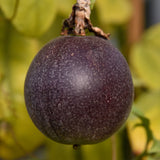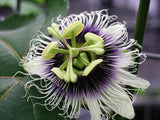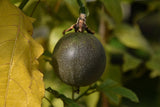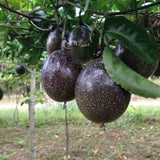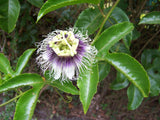🌺 Bloom & Fruit Character
‘Tom’s Black’ hails from the purple‐fruited form of P. edulis, so you’ll witness the exquisite, show-stopping blooms typical of the species: white petals and sepals accented with a prominent corona of fine filaments that often appear white tipped and purple at the base. While specific fragrance data on the ‘Tom’s Black’ cultivar is scarce, the species is reported to have fragrant flowers. After bloom, deep purple, nearly black fruit—with tangy aromatic pulp—appear, offering the edible payoff of the venture.
🧊 Hardiness & Growing Zones
P. edulis is a tropical to subtropical vine and is not reliably hardy in cold climates. Its suggested USDA hardiness is Zones 9 to 11 (or 9a–11b) under favorable conditions. One authoritative source lists winter hardiness only for Zones 10–12. In regions cooler than Zone 9, it functions best either as a container plant moved indoors for winter or as a strictly annual outdoors.
🦋 Wildlife & Ecosystem Connections
-
This passionfruit vine is attractive to pollinators: bees, carpenter bees, and other insects are drawn to its exotic flowers.
-
It also serves as a larval host plant for certain butterfly species. For example, it is listed as a host for the Tawny Coster (Acraea terpsicore) and the Sahyadri Lacewing (Cethosia mahratta) in documented observations.
-
Anecdotal and regional evidence suggests that related passion-vines attract the Gulf Fritillary butterfly’s larvae, making it a welcome addition to butterfly-friendly gardens.
Thus, planting this seed variety not only rewards you with fruit and flowers—it also fuels habitat for bees and butterflies.
📜 Cultural & Botanical Significance
The genus name Passiflora (literally “passion flower”) echoes centuries of symbolism: early missionaries recognized the complex structure of these blooms as metaphorical of the Passion of Christ, with its petals, filaments, stamens and styles representing the crucifixion story.
The species P. edulis originates from southern Brazil, Paraguay and northern Argentina, and has been cultivated across the tropics for its fragrant aromatic fruit and ornamental value.
By growing ‘Tom’s Black’, you’re participating in a lineage of botanical beauty, edible delight and ecological connection.
🌱 Why Grow ‘Tom’s Black’ from Seed?
-
Because you’ll enjoy striking tropical‐style vines, climbing trellises or fences, with exotic blooms that seem almost alien in complexity yet entirely garden-friendly when grown in the right zone.
-
Because the edible fruit yields a rich, aromatic pulp prized in kitchens and juices—a dark-skinned passionfruit with character.
-
Because you’ll be offering habitat & nourishment to pollinators and butterfly larvae.
-
Because you’ll be part of a story: from the wild tropics to your garden, nurturing a vine steeped in myth, flavor and ecological interplay.
📝 Quick Snapshot
-
Plant: Passiflora edulis ‘Tom’s Black’ (seeds)
-
Bloom: White and purple flowers with striking filaments; likely fragrant
-
Fruit: Dark purple/black rind, aromatic pulp
-
Hardiness: USDA Zones 9–11 (grow as container plant or annual in cooler zones)
-
Wildlife: Attracts bees & butterflies; confirmed larval host for some butterflies
-
Cultural notes: Passion flower symbolism, tropical heritage, edible and ornamental
Turn your garden into a vibrant tapestry of flavor, symbolism and wildlife—plant the seeds of ‘Tom’s Black’ and watch a vine unfold that delights your palate, your eyes and the pollinators that come to visit.






